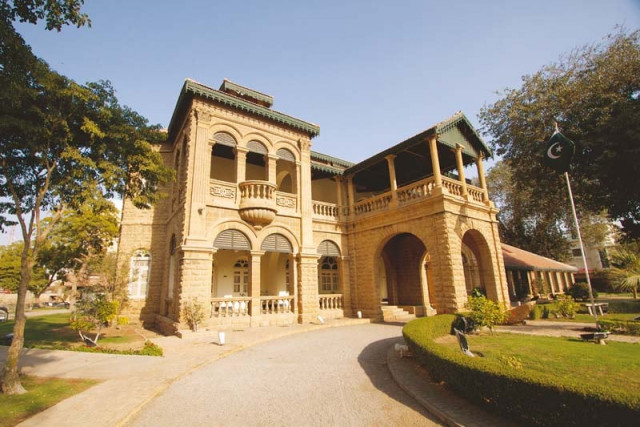
The historic building consists of arched openings, carved pillars, semicircular balconies and six spacious rooms, which include two bedrooms, two drawing rooms, one study and one dining room. The building was designed by a British architect, Moses Somake, also known for constructing other famous architectural structures in Karachi, such as Mules Mansion, Bai Virbaijee Soparivala Parsi High School, Karachi Goan Hall and Edward House. A tile on the roof has the date 1868 embossed on it, the year the house was constructed.

The house was named Flagstaff House as the British Indian Army rented it and allotted it to senior officers including General Douglas David Gracy, who later became the second commander in chief of the Pakistan Army, says Rasheed, the only guide at the house. “The house was purchased by Muhammad Ali Jinnah in 1943 from Sohrab Katrak, a former mayor of Karachi, for Rs115,000,” he says. “Jinnah paid Rs5,000 in advance and then paid the rest later.”
Rasheed walks visitors to the backyard of the house, describing the architectural elements. “There are servant quarters and a horse barn here which has been converted into a hall for guests. The garden has been renovated multiple times while the trees have remained untouched,” he shares. Opposite the back entrance door is a small room, now an administrative office, but originally used as the kitchen. “Quaid-e-Azam preferred the kitchen to be outside the house,” he adds.

Back entrance of the Flagstaff House that is now used as the main entrance to the museum. PHOTO: DANIAL SHAH
Once inside the house, Rasheed’s focus switches to Jinnah’s belongings. “Quaid-e-Azam’s belongings were restored to their original state in 1993,” he says, pointing to an old wooden chest with a glass door. “The crockery displayed in this chest was gifted to Quaid-e-Azam by the governments of China and Japan.” In the living room, Rasheed points out wooden furniture, including a long table used by Quaid-e-Azam and Fatima Jinnah when they held official meetings. A map of Pakistan made up of broken pieces of glass hangs on the wall, a gift from Rafique Motiwala, a businessman from Bombay. An old telephone set given by the government of America is placed on the side table while a figurine of a German Shepherd dog sits atop a shelf. A pencil sketch of Fatima Jinnah, made in 1963 by artist Sarah Ikhlaq, hangs on the wall in this room.

Rasheed narrates the history of the museum to visitors. PHOTO: DANIAL SHAH
Later, Rasheed guides visitors upstairs via a wooden staircase, pointing out family pictures of Fatima Jinnah and the Quaid’s daughter Dina Wadia displayed on the walls. Wadia last visited the house in 2004, upon an invitation from former president Pervez Musharraf. The upper floor, where Quaid-e-Azam and Fatima Jinnah lived, is divided into two portions. Quaid-e-Azam’s room has a collection of books, clothes, shoes and a cane that he always carried. A copy of the Holy Quran, wrapped in a silver cover with the Quaid’s name imprinted on it, is placed on a wooden book holder. “It was gifted to Quaid by the Aligarh Muslim League,” shares Rasheed.
After showing Jinnah’s room, Rasheed takes visitors to Fatima Jinnah’s room. “She started living here in late 1948 after the Quaid passed away and spent 16 years here,” says Rasheed. Pointing to a framed sketch of a lantern, he explains, “That is the final draft of the campaign poster for Fatima Jinnah when she contested the 1965 presidential elections.” After former president Ayub Khan won the elections, she left Flagstaff House and moved to Mohatta Palace. Rasheed explained that even the Quaid never actually lived in Flagstaff House but planned to. “He lived in the Governor General House and Ziarat Residency but would come to visit here often.”

Rasheed opens up the museum’s for visitors. PHOTO: DANIAL SHAH
On the tour’s last stop, Rasheed takes visitors to an open balcony on the first floor. “At that time, the sea was visible from here. This was a calm and serene place for the neighbourhood,” he says.
The fate of the house was decided after Fatima Jinnah passed away in 1967 as the Quaid-e-Azam Trust put the house up for sale. It was bought by the Pakistan Archaeology department for Rs5.1 million. They converted the house into a museum and renamed it Quaid-e-Azam House. In 1993, the house was officially inaugurated by Hakim Muhammad Saeed, the then-governor of Sindh.
The museum is open from 9:00am to 4:00pm every day except on Wednesdays. “I always wait for visitors to come and see the house of the founder of the nation. I am happy to receive students in groups from schools, colleges and universities,” says Rasheed. “However, the love for Quaid-e-Azam has been limited only to a currency note instead of his ideology of a State where every citizen should receive equal rights regardless of any religion, caste or creed,” he adds. When asked how long he has been a guide at the house, however, Rasheed does not comment. Instead he says, “What is important is the vision of the founder of Pakistan that has faded over time.”
Danial Shah is a travel writer and a photographer. He tweets @DanialShah_
Published in The Express Tribune, Sunday Magazine, March 15th, 2015.


















COMMENTS
Comments are moderated and generally will be posted if they are on-topic and not abusive.
For more information, please see our Comments FAQ